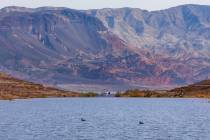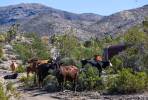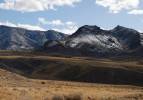Air Force, conservationists want Upper Las Vegas Wash protected
Air Force Col. Dave Belote shudders to think what would happen if the Bureau of Land Management makes public land available for development along a corridor where fighter jets with live munitions fly to reach the Nellis training range.
Conservationists concerned about rare plants and fossils from Columbian mammoths, camels and other animals from the ice ages fear dense housing would ruin the integrity of the area for future generations.
Those were the points made today on a tour of Upper Las Vegas Wash by Nellis Air Force Base officials, Protectors of Tule Springs Wash and Archeo-Nevada Society after researchers presented the BLM with studies to help the agency decide how much of the area to conserve and how much to sell for development.
“If there would be too much development to fly over, the reason for Nellis would be almost gone,” Belote said.
What’s more, he said, it would cost the Air Force billions of dollars to re-create the terrorist training camps, airfields and other targets on the 2.9-million-acre Nellis Air Force Range to the north, which is vital for training the nation’s fighter pilots using live and heavy munitions.
As it stands, about half of the 40,000 training sorties out of Nellis fly directly over the so-called Conservation Transfer Area. Such flights over residential and business developments would pose a safety hazard.
“If that is cut off by development, then we have squandered billions of dollars of assets,” he said.
In a letter Thursday to the BLM, Belote, the commander of the 99th Air Base Wing, said preserving Upper Las Vegas Wash would help protect not only the natural features of the wash but also another “national treasure,” the Nellis range.
“We can ensure the sustainment of both critical habitat and military air space, creating a win-win compatible future,” Belote wrote in the letter to Ron Wenker of the BLM’s state office in Reno.
Jill DeStefano, founder of Protectors of Tule Springs Wash, and Helen Mortenson, president of Archeo-Nevada Society, said the 13,000-acre wash near Sun City Aliante, now called Upper Las Vegas Wash, has some 500 sites representing 200,000 years of mammoth and fossil history from the ice ages, evidence of ancient man and rare plants. All are at risk to illegal off-road traffic, dumping and future development.
They want the area turned into a national conservation area or a national monument to coincide with plans for Tule Springs Ice Age Park complete with a research center and repository for Nevada’s fossils.
“We are asking it be contiguous with Desert National Wildlife Range,” DeStefano said, standing near an ancient spring mound where remains from a Columbian mammoth poke from the talc-like soil where it died 11,000 years ago.
Drivers of all-terrain vehicles “don’t know what they’re running over out here,” she said.
Earlier today, researchers from Utah State University presented studies of the area to BLM staff.
They made a detailed map of soil types and created a computer model for mapping and predicting locations of two “plants of interest” — the Golden Bearclaw-poppy and Nile’s wild buckwheat, both of which are listed as sensitive species.
Their analysis breaks the Upper Las Vegas Wash area into four components and then offers different options for how much to conserve in each part, which means there are hundreds of possible combinations. The team did not recommend any particular option.
Each option details the effect on rare plant habitat and prehistoric fossil sites, and the range is wide, from protecting less than 10 percent of a resource to protecting all or almost all of it. The full report is expected within a month.
The BLM should complete a draft environmental impact statement by Jan. 20. The public will have 45 days to comment on it, and there will be public meetings, said Gayle Marrs-Smith, project manager for the BLM.
A final decision on how much land to set aside is expected by mid-April, although that decision can be appealed.
“We wanted to have the best scientific information available to inform us ... so that we understand what the consequences are,” Marrs-Smith said. “We will have a boundary, and outside that boundary there will be uses, to include development.”
A separate study is under way to assess how water moves across the wash and how development could affect that flow.
Contact reporter Keith Rogers at krogers@reviewjournal.com or 702-383-0308. Contact reporter Alan Choate at achoate@reviewjournal.com or 702-229-6435.























